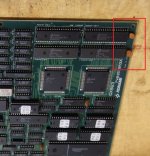Hi!
I have TMNT pcb with dodgy sound... The music cuts in and out on some levels - on others its fine.
I haven't done much by way of trouble shooting yet, just starting with this obvious issues.
Can anyone help identify the ceramic caps in this picture? They are both cracked and need to go.
I can't really make out details on them...

Thanks in advance!
I have TMNT pcb with dodgy sound... The music cuts in and out on some levels - on others its fine.
I haven't done much by way of trouble shooting yet, just starting with this obvious issues.
Can anyone help identify the ceramic caps in this picture? They are both cracked and need to go.
I can't really make out details on them...

Thanks in advance!




